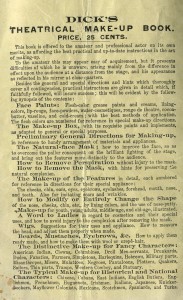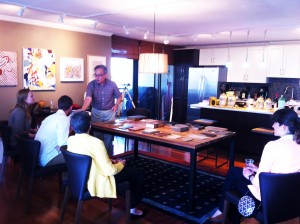Class Trip to an Auction
 During the 1st summer session (June/July) I am teaching AMST 851, a graduate course on “the world of rare books.” I have four students from American Studies, four from English, and one auditor from Simmons College’s LIS program.
During the 1st summer session (June/July) I am teaching AMST 851, a graduate course on “the world of rare books.” I have four students from American Studies, four from English, and one auditor from Simmons College’s LIS program.
Several of us attended a sale sponsored by New England Book Auctions, a firm that runs a few auctions per month out of the Hotel Northampton, serving mostly dealers but often collectors and librarians as well. The sale proceeded at a nice clip–faster than usual, and 215 lots were knocked down in precisely two hours. The Watkinson won the following items, to the delight of the students (and one of our new Board members, who came with us and purchased two items for his own collection).
A lot of ten (10) early 19th-century chapbooks for children (religious/moral/educational): two were published in London (with color illustrations) by the Wholesale Bible and Prayer Book Warehouse; two in Massachusetts (Worcester and Wendell); three in Philadelphia (issued by the American Tract Society); and three in New York (issued by the American Sunday-School Union).
 An edition of the history of the Jews by Flavius Josephus published in Vermont in 1819–a rather scarce book, all told–which was clearly intended for a Christian audience. There are only 13 copies listed in American libraries (five of which are in New England), and ours is the only copy in Connecticut!
An edition of the history of the Jews by Flavius Josephus published in Vermont in 1819–a rather scarce book, all told–which was clearly intended for a Christian audience. There are only 13 copies listed in American libraries (five of which are in New England), and ours is the only copy in Connecticut!
 A very small (4 x 2.5 inches) edition of John Wesley’s Thoughts on Slavery, originally published in 1774. This edition was produced in 1839 by the American Antislavery Society in New York. According to the preface: “To many it will probably be a matter of surprise, to perceive how exactly the sentiments of Rev. John Wesley, on the subject of American slavery, agree, not only with those put forth about the same time, in this country, by Hopkins, Franklin, Rush, Jay, Jefferson and others, but, also, with those now advocated by the American Antislavery Society. –Truth is immutably the same; and hence the wisest and best of men, in every age, and in every country, have invariably arrived at the same results, when reasoning on the momentous question of Human Rights. Though written more than sixty years ago, the reader will find, in the following pages, a minute and faithful account of Slavery as it exists in this nation; and the sin of slaveholding, and the duty of instant emancipation, are here demonstrated beyond the possibility of successful refutation. Let no one, into whose hands this little tract may fall, fail to give it a candid perusal.”
A very small (4 x 2.5 inches) edition of John Wesley’s Thoughts on Slavery, originally published in 1774. This edition was produced in 1839 by the American Antislavery Society in New York. According to the preface: “To many it will probably be a matter of surprise, to perceive how exactly the sentiments of Rev. John Wesley, on the subject of American slavery, agree, not only with those put forth about the same time, in this country, by Hopkins, Franklin, Rush, Jay, Jefferson and others, but, also, with those now advocated by the American Antislavery Society. –Truth is immutably the same; and hence the wisest and best of men, in every age, and in every country, have invariably arrived at the same results, when reasoning on the momentous question of Human Rights. Though written more than sixty years ago, the reader will find, in the following pages, a minute and faithful account of Slavery as it exists in this nation; and the sin of slaveholding, and the duty of instant emancipation, are here demonstrated beyond the possibility of successful refutation. Let no one, into whose hands this little tract may fall, fail to give it a candid perusal.”

 And finally, a rather excruciatingly racist minstrel show, The Nigger Boarding House: A Screaming Farce, by Oliver Wenlandt, published in 1898 (New York: Fitzgerald Publishing Corp.). This is also fairly scarce–only 13 copies are recorded, and this is one of only two in New England (the other is at Yale). On the title-page it reads, “in one act and one scene for six male burnt-cork characters,” and further, “with complete directions for its performance.” Also of interest to theater historians is a full-page ad on the inside front cover for “Dick’s Theatrical Make-up Book,” shown here.
And finally, a rather excruciatingly racist minstrel show, The Nigger Boarding House: A Screaming Farce, by Oliver Wenlandt, published in 1898 (New York: Fitzgerald Publishing Corp.). This is also fairly scarce–only 13 copies are recorded, and this is one of only two in New England (the other is at Yale). On the title-page it reads, “in one act and one scene for six male burnt-cork characters,” and further, “with complete directions for its performance.” Also of interest to theater historians is a full-page ad on the inside front cover for “Dick’s Theatrical Make-up Book,” shown here.

